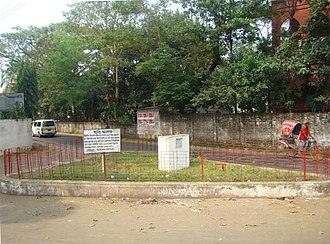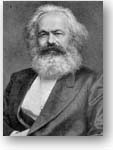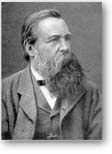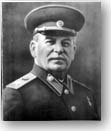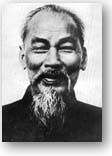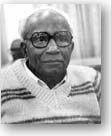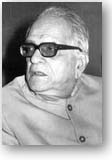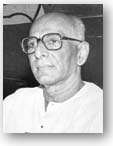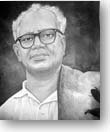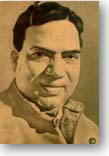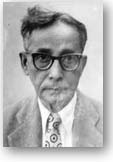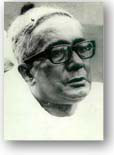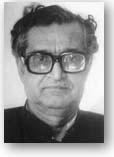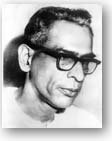Phanibhusan Dasgupta

Phanibhusan Dasgupta was born on the 27th Dec. 1907 in the village of Khalisakota (P.S. Buckergaunge ), Barisal ( Now Bangladesh). His father Aukhoykumar was a headmaster with very strong personality. Phani joined politics in his school days in secret organizations like 'Vivek Asram' and 'Sankar Math'. Subsequently he joined revolutionary 'Jugantar Party'.
That Phani wouldn't stay in family and would join the call of the country, was the apprehension of his parents. But to prevent it the parents decided to get him married at an early age. Even the daring Phani had no courage to say 'no' to his father. So he was married to a pretty girl named Sudha Sengupta in 1925, Feb. 10th. Phani had appeared I.A. (H.S.) exam. and aged 18, and Sudha read in class VII, aged 13 only at that time. After marriage Phani went to Calcutta , took admission in B.Sc. (Hons) in Scottish Church College. But education was a plea. He joined political activities in Calcutta.
Phani's first exposure was in publication of a weekly paper named "Swadhinata", the first issue being 5th Dec. 1928. The explosive articles in the paper took immediate attention of the law and order authorities of Calcutta. He was arrested on the 4th June 1928 under sedition charge (u/s 124A). He was convicted for 3 months R.I. It can be mentioned that this "Swadhinata" paper was again published after independence from 5th Nov 1953, as news daily being mouthpiece of the Communist Party under editorship of Bhupesh Gupta.
After release Phani again passed his life in underground. He was again arrested on the 17th March 1931 in Mechuabazar Bomb Case and was kept as detenue (on trial) in Hijli Camp jail of Midnapore. Two revolutionaries, namely Phani and Nalini(Das) escaped from the Hijli detention Camp and an award of Rs.1000 for each was announced for their search.
Then again they had to live hard life in underground. After this Phani-Nalini were involved in "Singa Dacoity Case". This dacoity took place in Singa village of Barisal, where some 7 or 8 persons raided the house of a rich man on 18th july 1932 with object of looting money. In those days extortion was made by freedom fighters to collect money for movement. This time a member of the family stealthily left the house to call on the village Chowkidar (police). The Chowkidar 'Entajuddin' came to resist the dacoits and threw a spear to kill Phani. But the target was missed. But when Phani retaliated with his revolver the target was a sure success even and Entajuddin died with a bullet shot on his head.
Phani and his accomplices went underground and police had no idea about the accused for months together. At last a traitor named Ramesh Sarkar along with some others caught Phani and his associate Sudhangshu Sengupta. They were caught in the village 'Adhuna' possessing bomb and revolvers.
Phanibhusan was judged for several months under special court of the Judge T.S.Ellis in Buckergaunge. He was then awarded life sentence and transportation to Cellular Jail (u/s366/365 and s.120B) on 8th Dec. 1932. After another two days on the 10th he was further awarded a sentence of 7 years. In Adhuna Arms find Case (u/s 19F and 20 ). And then he was sent from Barisal Jail to Alipore Central Jail for availing ship for Andamans.
But again he attempted to escape from Alipore Jail. He came out of the cell but could not cross the outer wall. He was caught and severely beaten. After this he was sent to Cellular Jail in Andaman.
Phani possibly joined the first hunger strike for 46 days in Cellular Jail. But owing to physical illness he was not allowed to join the second hunger strike . Actually the routine torture in Cellular Jail, his failure in some actions as well as repentance for killing an innocent village Chowkidar by firing caused temporary mental illness in him. His physique also went down.
Hence Phani was repatriated in the beginning of 1938. He was under prolonged indoor treatment in Calcutta Medical College Hospital. After a short recovery he was sent back to home at Barisal. He died on the 12th Feb. 1943 at an age of 35. After another two years his wife Sudha also died at an age of 31 keeping behind the son of Phani aged 4 years.
Sudha passed a tragic life. Over long years of marriage, when Phani was in jail or underground, Sudha lived in agony and solitude. Even when she went to take admission in a school she was refused admission, being a wife of a 'Swadesi' prisoner. At last when she got back her husband, he was less than a full man, having lost his memory and physical fitness. Thus the revolutionaries become heroes of the history but their wives' sufferings are never counted and they remain in silence of history.
Portraits of Phanibhusan are kept in the Cellular Jail and in Mahajati Sadan. The one you see is here can be seen at the Cellular Jail.
That Phani wouldn't stay in family and would join the call of the country, was the apprehension of his parents. But to prevent it the parents decided to get him married at an early age. Even the daring Phani had no courage to say 'no' to his father. So he was married to a pretty girl named Sudha Sengupta in 1925, Feb. 10th. Phani had appeared I.A. (H.S.) exam. and aged 18, and Sudha read in class VII, aged 13 only at that time. After marriage Phani went to Calcutta , took admission in B.Sc. (Hons) in Scottish Church College. But education was a plea. He joined political activities in Calcutta.
Phani's first exposure was in publication of a weekly paper named "Swadhinata", the first issue being 5th Dec. 1928. The explosive articles in the paper took immediate attention of the law and order authorities of Calcutta. He was arrested on the 4th June 1928 under sedition charge (u/s 124A). He was convicted for 3 months R.I. It can be mentioned that this "Swadhinata" paper was again published after independence from 5th Nov 1953, as news daily being mouthpiece of the Communist Party under editorship of Bhupesh Gupta.
After release Phani again passed his life in underground. He was again arrested on the 17th March 1931 in Mechuabazar Bomb Case and was kept as detenue (on trial) in Hijli Camp jail of Midnapore. Two revolutionaries, namely Phani and Nalini(Das) escaped from the Hijli detention Camp and an award of Rs.1000 for each was announced for their search.
Then again they had to live hard life in underground. After this Phani-Nalini were involved in "Singa Dacoity Case". This dacoity took place in Singa village of Barisal, where some 7 or 8 persons raided the house of a rich man on 18th july 1932 with object of looting money. In those days extortion was made by freedom fighters to collect money for movement. This time a member of the family stealthily left the house to call on the village Chowkidar (police). The Chowkidar 'Entajuddin' came to resist the dacoits and threw a spear to kill Phani. But the target was missed. But when Phani retaliated with his revolver the target was a sure success even and Entajuddin died with a bullet shot on his head.
Phani and his accomplices went underground and police had no idea about the accused for months together. At last a traitor named Ramesh Sarkar along with some others caught Phani and his associate Sudhangshu Sengupta. They were caught in the village 'Adhuna' possessing bomb and revolvers.
Phanibhusan was judged for several months under special court of the Judge T.S.Ellis in Buckergaunge. He was then awarded life sentence and transportation to Cellular Jail (u/s366/365 and s.120B) on 8th Dec. 1932. After another two days on the 10th he was further awarded a sentence of 7 years. In Adhuna Arms find Case (u/s 19F and 20 ). And then he was sent from Barisal Jail to Alipore Central Jail for availing ship for Andamans.
But again he attempted to escape from Alipore Jail. He came out of the cell but could not cross the outer wall. He was caught and severely beaten. After this he was sent to Cellular Jail in Andaman.
Phani possibly joined the first hunger strike for 46 days in Cellular Jail. But owing to physical illness he was not allowed to join the second hunger strike . Actually the routine torture in Cellular Jail, his failure in some actions as well as repentance for killing an innocent village Chowkidar by firing caused temporary mental illness in him. His physique also went down.
Hence Phani was repatriated in the beginning of 1938. He was under prolonged indoor treatment in Calcutta Medical College Hospital. After a short recovery he was sent back to home at Barisal. He died on the 12th Feb. 1943 at an age of 35. After another two years his wife Sudha also died at an age of 31 keeping behind the son of Phani aged 4 years.
Sudha passed a tragic life. Over long years of marriage, when Phani was in jail or underground, Sudha lived in agony and solitude. Even when she went to take admission in a school she was refused admission, being a wife of a 'Swadesi' prisoner. At last when she got back her husband, he was less than a full man, having lost his memory and physical fitness. Thus the revolutionaries become heroes of the history but their wives' sufferings are never counted and they remain in silence of history.
Portraits of Phanibhusan are kept in the Cellular Jail and in Mahajati Sadan. The one you see is here can be seen at the Cellular Jail.
This biography was provided by his grandson Sayantan Dasgupta




